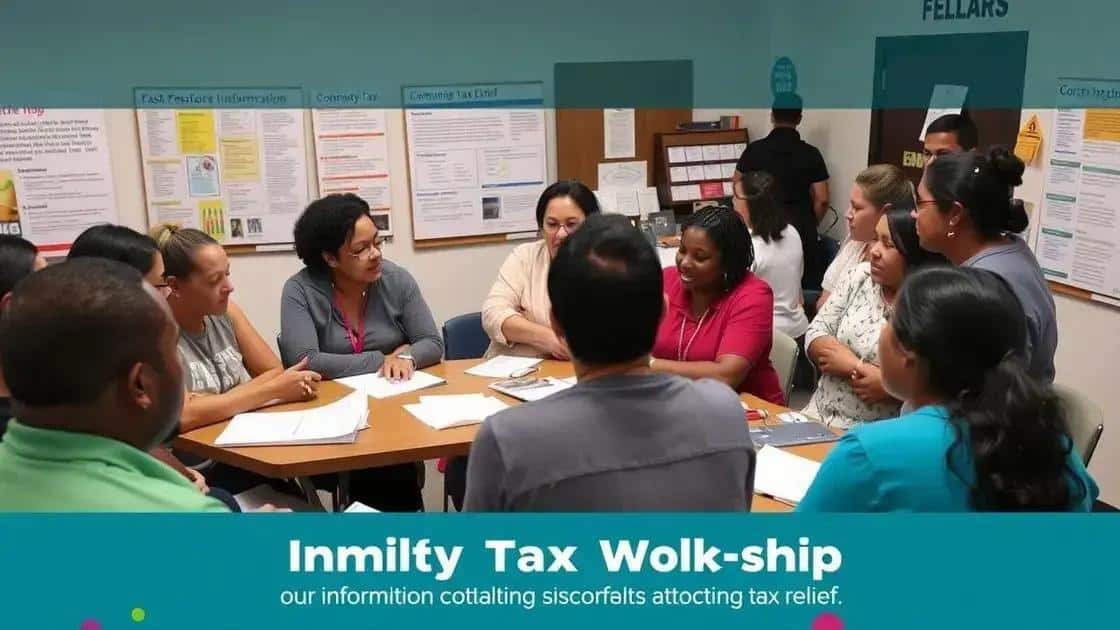Tax relief for low-income families: how to maximize benefits

Tax relief for low-income families includes programs like the Earned Income Tax Credit and Child Tax Credit, designed to reduce tax liability and provide essential financial support to those eligible.
Tax relief for low-income families can make a substantial difference in everyday finances. Have you ever considered how these programs might lighten your financial load? Let’s take a closer look.
Understanding tax relief programs
Understanding tax relief programs is essential for low-income families looking to ease their financial burden. These programs offer various forms of assistance that can significantly impact your yearly taxes. Let’s explore how these programs work and how they can help you.
What Are Tax Relief Programs?
Tax relief programs are designed to reduce the tax liability of individuals and families, especially those with limited income. They may come in the form of deductions, credits, or exemptions. By taking advantage of these programs, families can keep more of their hard-earned money.
Types of Tax Relief Programs
- Earned Income Tax Credit (EITC): This credit helps low to moderate-income working individuals and couples, particularly those with children.
- Child Tax Credit: This credit is available for families with dependent children and can significantly reduce tax bills.
- State and Local Tax Deductions: Some states offer deductions that can reduce taxable income further.
- Food and Nutrition Assistance: These are not direct tax reliefs but can improve overall financial health for families.
Each program has specific eligibility requirements, so it’s essential to review them carefully. Besides federal programs, many states also offer their tax relief initiatives. These can vary widely depending on the location and specific needs of the community.
Why Understanding These Programs Is Important
Being aware of available tax relief programs is crucial as it allows families to plan more effectively for their finances. By maximizing their benefits, families can allocate more funds toward essential services like education and healthcare. It can even help in saving for the future or addressing emergencies.
In conclusion, grasping the details of tax relief programs not only gives families a financial break but can also empower them to make informed decisions about their finances. Seeking help from tax professionals or community programs can further enhance understanding and access to these benefits. Don’t overlook the potential savings offered by these critical programs, as they are designed to support those who need it most.
Eligibility criteria for low-income families

Eligibility criteria for low-income families looking to benefit from tax relief programs are often straightforward but essential to understand. Knowing these criteria can help families determine their eligibility and maximize their benefits.
Income Limits
Typically, income limits are based on the number of household members and the total annual income. Families must ensure their income falls below a specific threshold. This can vary by state and program, so checking local guidelines is crucial.
Filing Status
Your filing status can also influence your eligibility. Most tax relief programs have options for:
- Single filers
- Married filing jointly
- Head of household
Each category may have different income limits that determine access to credits and deductions.
Residency Requirements
Many tax relief programs require families to be residents of the state in which they apply. Proof of residency, such as utility bills or rental agreements, may be required. These requirements ensure that assistance goes to those who truly need it within the local community.
It is important to gather all necessary documentation, such as proof of income and residency, when applying for tax relief. This preparation can save time and lead to a smoother application process.
Accessibility to these programs can significantly reduce the financial strain on low-income families. By understanding the eligibility criteria, families can take proactive steps to access the support they need.
Maximizing your tax benefits
Maximizing your tax benefits is vital for low-income families. By understanding and utilizing available programs, families can significantly improve their financial situation. This involves knowing which credits, deductions, and strategies can lead to saving money on taxes.
Identify Available Credits
There are several tax credits designed specifically for low-income families. The most notable one is the Earned Income Tax Credit (EITC). This credit can provide significant financial support. Families should also look for the Child Tax Credit, which helps reduce the tax burden for those with dependents.
Keep Accurate Records
Maintaining detailed records of income and expenses can aid in maximizing tax benefits. Keep all documents related to:
- Income, including pay stubs
- Childcare expenses
- Health care costs
- Charitable donations
Accurate records ensure that families can claim all eligible deductions and credits when filing their taxes.
Furthermore, utilizing free tax preparation services can assist families in navigating the complexities of tax codes. Many community organizations offer help to ensure that low-income families take full advantage of the benefits available to them.
Filing Status Matters
Your filing status can impact your tax benefits. Choosing the correct status could potentially lead to higher credits. For instance, those who qualify as head of household may receive a more favorable tax rate than those who file as single.
It’s essential for families to stay informed about changes in tax laws as these can affect eligibility and benefits yearly. By regularly reviewing tax information and consulting with financial advisors if necessary, families can ensure they’re making the most of their tax benefits.
Common misconceptions about tax relief

Many families have common misconceptions about tax relief, which can lead to confusion and missed opportunities. Understanding the truth behind these myths is essential for low-income families to optimize their tax benefits.
Myth 1: Tax Relief Is Only for the Wealthy
One prevalent belief is that tax relief programs primarily benefit wealthy individuals. In reality, there are numerous programs targeted specifically at assisting low-income families. Programs like the Earned Income Tax Credit (EITC) and the Child Tax Credit are designed to support those with limited incomes.
Myth 2: All Tax Relief Programs Are the Same
Another misconception is that all tax relief programs offer the same benefits. Each program varies significantly in the criteria it uses and the financial assistance it provides. For example, the EITC supports working families, while other programs may focus on education or housing. Understanding the specific benefits and requirements of each program is crucial.
Myth 3: You Can Only Claim Tax Relief Once
Many believe they can only receive tax relief a single time. In truth, many of these benefits can be claimed annually as long as eligibility criteria are met. It’s essential for families to apply for these benefits every tax year to maximize savings.
The perception that tax relief is complicated can deter families from applying. However, there are resources available to help. Numerous community organizations offer assistance in navigating tax relief options, making the process more manageable.
By debunking these common misconceptions, families can approach tax relief with more confidence. Knowing the reality promotes better decision-making, empowering families to take advantage of the support available to them.
FAQ – Common Questions About Tax Relief for Low-Income Families
What is the Earned Income Tax Credit (EITC)?
The EITC is a tax credit for low to moderate-income working individuals and families, which can reduce the amount of tax owed and may even result in a refund.
How can I determine if I qualify for tax relief programs?
Eligibility often depends on income level, family size, and filing status. It’s essential to check the specific requirements of each program.
Do I need to apply for tax relief every year?
Yes, it’s important to apply for available tax relief programs each tax year to ensure you receive all eligible benefits.
Are there resources available to help navigate tax relief options?
Absolutely! Many community organizations offer free tax assistance and resources to help families understand and apply for tax relief programs.






